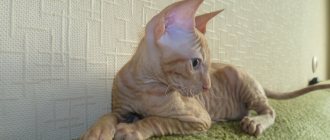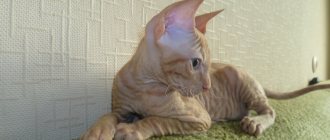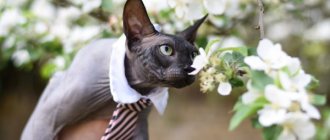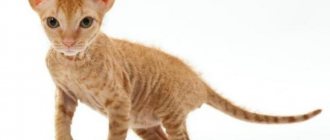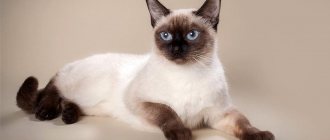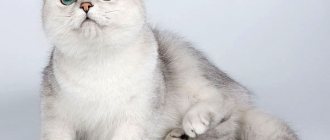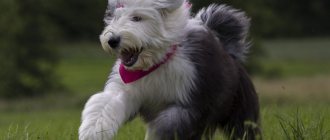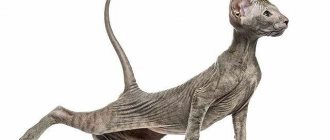Velor Sphynxes differ from the ones we are used to in that they have a little fur. Some people don’t like hairless or “half-naked” cats, but this only applies to those who have not personally interacted with them. These creatures conquer even those who were initially disgusted by their appearance. They are incredibly affectionate, intelligent, trainable, and bond with their owners just like dogs. Velor individuals are a variety of Donskoys.
They appeared in Rostov-on-Don in nineteen eighty-seven from the cat Varvara. If you cross a completely hairless animal with a normal one, you can get three types of kittens - bald, without eyebrows or mustaches, velor and brushed - with curved dense fur. Having decided to have such a four-legged friend, you will never regret it, because he will give you positivity and positive emotions every day! You will love him like a real family member, your family will be delighted with him, even if at first they wanted to have a cat of a different variety.
Origin story
First of all, the difference between these two breeds lies in their origin.
Their homeland, as their name suggests, is Canada, or more precisely, the city of Ontario. It was in this second largest city in the country that the purposeful breeding of unusual hairless cats first began in the sixties of the last century.
It all started with a hairless kitten, born to an ordinary domestic cat, which, due to the lack of fur, was significantly different from its brothers and sisters. The amazing baby was named Prune. He turned out to be a carrier of the gene responsible for hairlessness.
But Prun was not destined to become the founder of a new unique breed of cats, since the breeders made one serious mistake. They crossed Prun exclusively with his sisters and nieces, and after several generations, the kittens, due to such close family ties, were born weak and often died a few days after birth.
Perhaps the world would never have known about the Canadian Sphynx if not for another hairless cat who was born in the American city of Wadena, and who was named Epidermis. American breeders turned out to be more cautious than Canadians, so they tried to find a cat to mate with Epidermis, with whom he would not be connected by blood ties.
There is a version that the Americans still managed to find distant descendants of Prun, who, together with Epidermis, were used for selection work to develop a new breed. This time, the breeders were lucky and were able to get several generations of completely healthy hairless kittens. The new breed was called the Canadian Sphynx, in honor of the first hairless cat born in Canada.
Don hairless cats are more than thirty years “younger” than their Canadian counterparts and appeared a thousand kilometers from America - in the Russian city of Rostov. Their story began with the bald cat Varvara, who was sheltered by a woman with a kind heart, Elena Kovaleva. Convinced that the pet’s hairlessness was due to some unknown disease, Elena even turned to veterinarians to cure her. But Varvara surprised her mistress by giving birth to babies as hairless as herself.
Russian breeders became interested in the unusual hairless kittens and wasted no time in starting selection work to breed them. The Russian sphinxes received their name in honor of the mighty deep river - the Don.
The difference between these two breeds is not only in their origin, but also in the fact that Canadian Hairless cats are today recognized by all international cat organizations, while the Don have received the status of only an experimental breed.
How to choose a kitten
It is recommended to purchase a kitten only from trusted nurseries, since they may offer you not an exotic baby, but a sick animal. This is due to the difficulties of breeding the breed and the dishonesty of sellers.
You should not buy a kitten that is too young, as its body is still weak and can get an infection when moving, even under stress.
Reference! The optimal age for a baby to buy starts from 3 months. By this time, the baby is already strong and has the necessary vaccinations.
If your future pet is a personal companion and not a show winner, then it is enough to make sure that he is healthy. The kitten should be active, cheerful, and not show aggression or fear at the sight of a person. Sometimes kittens have a small rash on their tail - there is nothing wrong with that, it will go away on its own over time.
The final color of the kitten, as well as the color of the eyes, become clear to an experienced breeder already in the first weeks of the baby’s life.
It’s worth noting right away that sphinxes are not a cheap pleasure. If you are offered to buy a kitten for 3-4 thousand rubles, in this case there can be no talk of any pedigree.
The price of kittens in trusted nurseries starts from 10 thousand rubles.
Kittens that have deviations from breed standards are a little cheaper. They are not critical if you take a handsome bald man for your soul.
But promising kids - potential exhibitors and future producers, whose parents have championship titles, will cost at least 15 thousand rubles .
Description of the breed
The appearance of these animals is unusual - they have hard hair on their muzzle and paws, and the same on their tail. Sometimes there are specimens in which fur grows exclusively on the legs and the body is bald. Here are the distinctive features of all these animals:
- The fur is coarse, slightly curly. As a rule, babies are born with normal fur, and only then does it thin out. In the fall, many people grow longer hair - they are insulated for winter - and in the spring everything falls out, only the paws and tail remain hairy.
- They have no eyebrows, their skin is velvety, like velor, their mustache may be either absent or curly.
- The eyes are angled and oval.
- The back is strong, muscular, straight, the tail is also straight, the limbs are of medium length, thin, graceful, strong, the fingers also seem elongated.
- The tail is thin and elongated, rounded at the end.
- The head is wedge-shaped, the cheekbones and brow ridges are clearly visible.
- The muzzle is medium, the nose is without depressions or humps, the chin is small, the ears are large.
- The colors vary. The most common species are white, blue, red, black and sometimes lilac.
- The size is usually small, but there are also large cats.
- The skin is soft and wrinkled, elastic, and there are wrinkles on the head, tail, paws, neck and belly.
- There is no musky smell, males rarely mark territory.
- Females are smaller, they have a narrower chest, thin neck and small head. The weight of the animal is three to five kilograms.
- The lifespan of the animal is twelve to fifteen years.
- Babies' eyes open a few hours after birth.
There are three subtypes of hairy sphinxes:
- velor, whose hairs are sparse, short and dense,
- point, distinguished by velor hairs on the body and curly, short, coarse hair on the paws, tail and muzzle,
- dense, with hard and frequent fur, through which the body cannot be seen.
brief information
| Breed name | Don Sphinx Brush |
| Country of origin | Russia |
| Coat | hard, sparse, short, stubble-like hair |
| Height (height at withers) | 25-30 cm |
| Weight | cat – 3.5-5 kg, cat – 5-7 kg |
| Lifespan | 12-15 |
| Breed characteristics | inquisitive, friendly, active |
| Kitten price | 15-30 thousand rubles |
Don Sphynx
At the end of the eighties of the last century, the first hairless cat was born in Rostov-on-Don. From her the Don breed of sphinxes began. In the Don breed, baldness is caused by the presence of the dominant Hbl allele in the genotype. There are four main groups of this type: naked, flock, velor, brush.
Holoborn ("rubber")
The name speaks for itself - kittens are born without a hint of fur. Moreover, they may lack mustaches and eyebrows, as well as sensitive hairs on their paws. The skin of such animals resembles rubber or plasticine; it is warm, sticky, with a large number of folds on the head and body. Babies can be born with their eyes open, as is the case in humans.
We recommend reading: Fighting dog breeds: TOP 10 with photos and names
The elastic, thin skin does not yet have its final color. The future color of the animal (blue, black, spotted) can be recognized by the pads on its paws. Some individuals grow sparse fur in winter, but it disappears in spring.
Larger animals remain naked with many folds throughout their lives. They are of great interest to breeders.
Flock
Kittens are born with barely noticeable fluff all over their skin, like peaches. The tactile sensations from touching their skin are very pleasant and unusual; cats resemble plush toys. By the age of two, the hair becomes thinner, the hair follicles die off, and the animals become completely bald.
Velours
Velor, like flock, only visually looks bald - when you take the kitten in your hands, you feel soft fluff all over the body, like lint on velor fabric. Unlike flock, the hair on this type of animal is longer and thicker, especially on the face, paws and tail. The top of the head remains completely bald. By stroking your baby against the grain, you can notice how quickly his even hair is restored.
Velor kittens are divided into types based on the condition of their coat. Lightweight - has a minimum hair length of two millimeters. They are thicker on the paws than on the body. Some kittens have coarse hair, others have soft hair. There is no hair on the top of the head.
Point - the coat has a relatively long pile (four millimeters) on the face, tail and limbs. Points appear in winter, then their expressiveness decreases.
Downy appearance - the cat is completely covered with delicate wavy, rather long hair. In addition, the animal has a surprisingly cute tail.
By the time of puberty, the velor Sphynx becomes completely bald and only some cats walk around with a remnant of fine hair on their paws and head.
Brush
Brush translates as “bristle-bristled.” The fur of these animals really looks like an old brush - hard, sparse and twisted. There are animals with bald heads, necks and limbs. This species is used to maintain the population, but they have no value for the breeder, and they cannot expect titles at exhibitions. Brush are good as one of the parents for the continuation of the species. The fact is that you cannot cross two naked individuals - this leads to mutations and stillborn kittens.
The Brush can shed its fur by the age of one and a half years, but this does not apply to the dense type. His fur is so thick that his skin cannot be seen through it. The tail is especially well covered with it, as well as a lot of hair on the paws and chest.
Content
Sphynxes need sunbathing, after which the skin acquires a rich shade. But direct exposure to the sun's rays has a negative impact on health, and the cat can get burned.
Such hairy animals require careful care. It is important to regularly wipe the corners of your eyes to remove accumulated dirt and mucus. This can be done with a soft cloth soaked in warm water or with cotton pads in the direction from the edge to the center. The fluffy Sphynx tends to sweat, for this reason it is recommended for them to bathe with a mild, specialized shampoo. After taking water procedures, it is imperative to wipe the animal with a warm terry towel until completely dry. If the dirt on the cat's skin is small, you can wipe the area with wet wipes for animals that do not contain alcohol.
Particular attention should be paid to cleaning the ears of wax; in these animals it accumulates in large quantities. You can clean your ears using cotton swabs moistened with water or a special product. Sphynxes prefer to eat natural food, but you can also feed them premium and superpremium ready-made factory food.
join the discussion
Share with your friends
The appearance of hairless sphinxes in the last century frightened and delighted people. Many did not understand how one could fall in love with a hairless cat. After all, this animal should be soft and fluffy, pleasant to the touch, a real antidepressant.
Some twenty years have passed, and attitudes towards sphinxes have changed. If you get this breed, you expect a complete lack of hair. The Internet is replete with indignation like: “I bought a Sphynx, but its fluff is growing, what should I do? Maybe he’s not a sphinx?
You don’t need to do anything - just love the animal. Sphynxes come in different varieties, and the presence of fur on some species is normal . To understand whether sphinxes have hair, we will give a description of some species of this animal.
Types of Sphynx coats
Brush animals were not bred on purpose - they appeared as a result of a gene mutation after crossing different types of cats. There are several types of Sphynx with fur, differing in the length and type of hair.
Flock
The body of pets is covered with a thin velvet pile, similar to the fluff on the surface of a peach. The fluff is very soft to the touch and almost invisible. The densest coat is found on the paws and tail. In the absence of developmental anomalies, by the age of 2 years all the hairs fall out on their own, and the animal’s skin is completely exposed.
Velours
The velor pet of the Sphynx breed has a bald head, and the hair length on the body reaches 2–5 mm - in appearance they resemble partially bald street cats. Most often, by adulthood, these animals also become bald, but sometimes the fur remains throughout their lives. Often the lint remains only on the paws and tail.
Brush
Pets of this breed differ in the density of their coat:
- Brush velor Sphynx kittens have hard hair that resembles stubble. On the sides and neck the fur is thinner, the skin is visible through it. With age, the fur can soften, and then the velor brushed Sphynx becomes more similar to representatives of the flock breed.
- After birth, the body of the Pointed Brush is covered with long and thick hair, and a barely visible bald patch stands out on the head. By 18–24 months, the length of the hair on the body remains about 1–2 mm, and on the tail, muzzle and paws the hair reaches 10 mm, becoming curly in some places.
- A kitten of the dense brush breed looks like an animal with straight fur - it does not have a bald spot on its head. Over time, the structure of the hairline changes - it becomes thick, and the skin is practically not visible through it. On the paws, chest and tail, the hair is longer and stiffer, and can be either straight or curly.
Note! Pets of this breed do not take part in exhibitions, but they are crossed with other types of sphinxes - this allows them to get strong offspring. This selection is due to the fact that when two representatives of hairless sphinxes are brought together, very weak or dead kittens are born.
Straight-haired
Straight-haired Sphynxes do not go bald over the years - they still have short hair that fits tightly to the skin, and pronounced, long whiskers. The breed appeared as a result of the mixing of Siamese or Oriental cats with Sphynx cats.
We recommend reading: Saarloos wolf dog: description, breed standards, character, care and maintenance, prices, photos
What to look for when choosing
Don Sphynxes are extremely demanding pets to care for. Deprived of a natural protective coat, they must have strong immunity, resistant to external threats. Breeders advise buying kittens of this breed only in specialized nurseries. This makes it much more likely to get a healthy, mentally stable pet.
Advice! You need to take the little Donchak to a new home no earlier than 12 weeks. Babies are very fragile and often die at an early age, so they cannot be separated from their mother early.
In addition to good health, three-month-old kittens have a number of other advantages: they are litter box trained, socialized, and have received the necessary first vaccinations. The breeder must give the baby's veterinary passport with vaccination records to the new owner.
Don Sphynx kitten
It is advisable to buy a Donchak in the place where he was born and grows. This will provide an opportunity to observe the behavior of the kitten’s parents, brothers and sisters. Adult animals should behave calmly.
Unreasonable aggression may indicate shortcomings in the upbringing or health problems of the pets. Such individuals are disqualified and are not allowed for breeding. Little cats are always very curious, playful, and enjoy meeting new people.
The appearance of kittens may vary depending on the type of cat. Hairless Donchas are born bald, velor or flock are covered with sparse hairs, which are “shed” as the cat grows up. Brushes are born with fairly thick fur and acquire a characteristic appearance only in adulthood. Up to two years, the covers of the Don sphinxes are unstable. Naked individuals can be covered with fluff in winter; brushes sometimes go into the category of folk or velor.
The kitten needs to be examined carefully. A healthy purebred Sphynx has the following characteristics:
- almond-shaped eyes without signs of suppuration;
- the tummy is round, but not bloated;
- teeth white, straight;
- pear-shaped body;
- The ears are clean, wide at the base, rounded at the tips.
The skin of little Donchak needs to be examined especially carefully. You should refuse to purchase if you notice the slightest signs of peeling, rashes, or eczema.
Prices for kittens
You should not respond to advertisements on the Internet in which owners offer to buy a Don Sphynx kitten for an amount from 3 to 5 thousand rubles. At this price they sell defective individuals from unplanned (or frequent) matings. There is a huge risk of buying a sick, non-viable baby. So how much does a purebred kitten cost?
Cat breed British Chinchilla, a long-haired miracle with green eyes and a calm character
The cost of a kitten in a nursery depends on the cat’s exhibition data and the “merits” of its parents. A purebred pet-class Donchak (with deviations from breed standards) costs 7–8 thousand rubles. This pet is suitable for those who want to buy just a pet. He has all the necessary documents, has characteristics characteristic of the breed, but does not participate in exhibitions and matings.
Breed-class cats can be bought for 15,000 rubles. They do not receive first places at exhibition events, but are allowed for breeding. Representatives of the show class, born from champions, with excellent prospects, cannot cost less than 30,000-35,000 rubles.
Sphynx brush colors
Brush Sphynx cats can have a wide variety of colors, among which the following types of colors are distinguished. There is a specially developed table of brush color codes in which you can see the identity of your kitten.
Sphynx color coding table.
Material on the topic: popular colors of the Scottish cat breed.
Plain
This type is also called solid color or solid color. With this type, the cat has a uniform color over its entire surface.
- White. This color is found in all cat breeds.
- Black. It can range from a deep rich color to gray, depending on the thickness of the coat.
- Blue. This color is a variation of the black color, but can be confused with it. To accurately determine the exact color of the animal, it is determined by the color on the stomach, eye rims, lips and testicles.
- Red. This color always has a tabby pattern. Sometimes this color can be confused with cream.
- Cream. A variety of red color.
- Pink sphinx.
Rare colors
These colors include various tortoiseshell colors, which are most often found in cats. There are different varieties of this color:
Sphinx Brush at three years old.
Black turtle - combination of red and black;
- Blue - a combination of cream and blue colors;
- Turtle cinnamon;
- Turtle cream;
- Turtle Lavender.
There are other colors of Sphynx brushes that are also common among these cats:
- Chocolate. This is one of the black color options. This color is considered rare and does not occur often in this breed.
- Lilac. A type of chocolate color, but in light shades. Also applies to rare colors.
- Particolors. This can be bicolor and calico and the so-called calico chintz. It is a combination of tortoiseshell color combined with white.
- Color point.
- Tabby. There are several varieties of this pattern - marble or classic, tiger.
Rarer and more expensive tabby colors, which are especially valued among breeders, are:
- brown tabby;
- silver tabby;
- blue tabby;
- red tabby;
- cream tabby;
- chocolate tabby;
- cinnamon tabby;
- lavender tabby;
- fawn tabby.
The type of color does not affect the length of the animal's coat; the average hair length does not exceed 5 mm. and may vary depending on the molting period and other influencing factors.
Brush sphinx.
Straight-haired
The basis of the species is the selection of Siamese and Oriental cats with Sphynxes. These animals do not have the baldness gene; they have normal fur and mustaches. The coat is short, close to the body, of the oriental type. The color of the Peterbald often repeats the color of its ancestors - the Siamese and Oriental groups.
Health and disease of the Brush Sphynx
Once every three months, the cat needs to be prevented from worms, and revaccinated once a year, according to the recommendations of veterinarians. One of the most common problems these animals face is diseases associated with the skin - dermatitis, irritation, rashes, etc. Congenital pathologies are rare in this breed, but they can acquire diseases that are more characteristic of them.
- Microphthalmos. A congenital pathology of the eyelids, in which the eyeball is smaller or underdeveloped, which can cause poor vision or complete blindness. The reasons for this have not been fully identified and are only being studied. With this pathology, veterinarians simply remove the damaged eye and, if possible, perform plastic surgery.
- Short lower jaw. Most often, this pathology occurs among Donetsk residents. In this case, an incorrect bite occurs, the jaws come into contact with each other and do not completely align.
- Turning of the eyelids. Characterized by weakening of the muscles of the eyelid ligaments. Solved surgically.
- Dermatitis. Type of skin disease.
- Nipple hyperplasia. It is often transmitted genetically through the female line. The risk group includes females with light blue tones.
- Trichophytosis. The type of fungal disease is similar to lichen.
The breed is distinguished by its strong health. If you follow proper care, a balanced diet, contact veterinarians on time and get all the necessary vaccinations, your pet will be a joy for a long time. They rarely get sick, thereby causing their owners trouble and expense.
Feeding
A velor kitten up to 3 months old should eat 5 times a day
Velor Sphynxes have an accelerated metabolism. To maintain the required body temperature, they consume more food than purrs of other breeds. Premium or holistic food is suitable for them. They contain quality ingredients and healthy vitamins. Such products include:
- Orijen Cat & Kitten;
- Purina Pro Plan;
- Royal Canin Sphynx Adult.
If you decide that your pet will eat natural food, try to maintain a balance between serving size and quality. Sphynxes can be given: lean fresh meat, boiled vegetables, cereals, eggs and sea fish. Do not feed cats: river fish, pork, bones, sweets. Representatives of this breed do not chew food well, so there should not be large pieces in his bowl.
Animals that eat natural foods need mineral supplements and vitamins. Find out at your veterinary clinic which medications are suitable for your pet.
Tailed animals up to 3 months should eat 5 times a day, kittens up to 6 months - 4 times. After 6 months they can eat 3 times a day. When changing your cat's diet, you need to follow your veterinarian's recommendations.
Skin care and bathing
The Sphynx breed, due to its physiological characteristics, needs more frequent bathing than their furry counterparts. This procedure must be done correctly so that the cat does not experience stress and avoid health problems. It is better to do this in a shallow container or bath; the depth of the water should not exceed 15 cm. Cats are often frightened by the stream of flowing water.
It is recommended to use special care formulations or products for children as shampoo. They do not contain harsh ingredients that can cause irritation, and this breed has very sensitive skin.
Sphinxes have a high temperature, so they need to be washed with preheated water. The optimal temperature should be 36-39 degrees. When washing an animal, you need to calmly talk to it and stroke it so that the animal remains calm and does not get nervous. The amount of shampoo depends on the degree of soiling of the cat.
We recommend reading: The cat has a white film on his eyes: causes of the disease and methods of treatment
Table describing care procedures for Sphynx cats.
In some cases, you can do without it altogether by simply bathing it in warm water. When bathing, water should not get into the animal's ears, as this can lead to inflammatory processes. In this case, it is not recommended to wash your hair at all; you can use wet wipes.
It is not recommended to wash kittens that have recently been given a new home and have not yet had time to adapt to their new living conditions. The Sphynx should be bathed at least once every ten days. After bathing, the animal should be thoroughly dried and the room should be warm. Otherwise, the cat may catch a cold.
Sphynx kitten at six months.
Reviews
Almost all owners of velor cuties speak positively about them; they claim that their life has become much more interesting and enjoyable after the appearance of such a pet in the house. He is incredibly affectionate and can make anyone laugh, lifts the mood and helps relieve stress. Cats purr and meow constantly, but they do it unobtrusively and almost musically.
Many people note that such cats eat funny - they open their mouths as wide as they can, grabbing food. If you give them a tasty treat, they will take it with their paw, bring it to their nose with interest, examine and sniff it, and then intelligently eat it. They are extremely photogenic and love to pose. Those owners who have children note that such an animal becomes a source of pride for the child; he boasts about it to friends and often plays with it.
Breeding
To breed Sphynx Brushes, the animal should be purchased from a professional, registered breeder. The most expensive are the naked ones, the sphinx velor is cheaper, while the brushes themselves are of average cost. The cost is affected by the gender and color of the animal. It may be difficult to find a partner, since in Russia this breed is not considered the most popular.
How to choose a kitten?
You need to choose a kitten based on its health, knowing its pedigree. The kitten must have documents indicating its parents and grandparents. The kitten itself should be playful, active, and moderately inquisitive. There should be no discharge from the eyes and ears; this may indicate possible health problems. The animal must have all the required vaccinations and a veterinary passport with vaccination marks.
Choosing a name
It is necessary to choose a name based on the individual characteristics of a particular animal. This could be his character, origin story, interesting facts related to him.
Price
Sphinx Brush is a case where price determines quality. The price cannot be low - focus on the price tag of $300. A high price will mean that the kitten has a pedigree. We also advise you to purchase babies only from trusted breeders, so the likelihood of buying a healthy kitten is much higher.
Brush Sphynxes are fragile creatures that require regular care and attention, so before purchasing a kitten, it is important to correctly calculate your strength to provide it with a decent life. Otherwise, there is a high risk of developing diseases that can significantly shorten the pet’s life.
Did you like the article?
Advantages and disadvantages of plush sphinxes
Adult Don Sphynxes reach 30 centimeters at the withers, males look larger, and their weight ranges from 6 to 7 kilograms, while females weigh no more than 5 kilos. With proper care, representatives of the Brush breed live 14–17 years.
Interesting! The Sphynx Brush's body temperature fluctuates between 38-39 degrees, so when you touch your pet's skin it feels hot.
Advantages of the little hairy dog of this breed:
- friendly attitude towards children, lack of aggression towards other people;
- high intelligence, ability to train;
- easy contact with other animals;
- cleanliness;
- long lifespan, provided proper maintenance;
- absence of fleas and hair around the house.
A hairy pet also has a number of disadvantages:
- the need for regular skin care;
- the importance of maintaining the correct microclimate in a living space;
- increased susceptibility to dermatological type pathologies;
- specific body odor;
- insatiable appetite, increasing the risk of obesity.
Character
Velor beauties are very affectionate
Don Sphynxes are friendly cats. These are companions who are happy to spend time next to people: they love to lie on the couch with their owner, and run after a person around the apartment. Purrs, as sociable animals, find it sad to be alone for a long time. They are loyal, non-aggressive, but can be offended if the owner swears loudly.
The tailed cats of this breed are comfortable with living with dogs and other medium-sized pets. In addition, they get along with children: they are ready to play with kids and do not scratch. Animals are especially active when they are young. Adult cats prefer a quiet rest, but sometimes they are not averse to frolic.
Don Sphynxes are distinguished by their intelligence. They can be trained. But at the same time, you cannot roughly force the animal to obey, otherwise the pet will become stubborn. It is better to use the reward method - for each execution of a command you need to treat the cat with a treat. Hairless purrs can learn different tricks. Tailed animals are able to understand the requirements to “sit” and “lie down”. They love to fetch the ball.
Why does the Sphynx begin to grow hair?
Kittens and adult Sphynx cats sometimes begin to grow hair. There may be several reasons.
- Cold weather.
With the onset of cold weather, most sphinxes are covered with short fluff; in some areas of the body the hair can be quite long. It can grow back even if it only got cold outside the window, but the temperature in the house was always maintained at a comfortable level. - Heredity.
Canadian Sphynxes are the most stable breed. The appearance of fur on them usually indicates the “sins” of the breeder and accidental interbreed matings. You can expect everything from Donetsk, Peterbald, Levkoy and other hairless breeds. They are on the path of becoming. It happens that kittens do not shed their fur and this cannot be predicted, and adult cats can grow and remain fluffy. - Hormonal changes.
Wool can grow rapidly or, on the contrary, fall out as a result of puberty, pregnancy, castration/sterilization, disruption of the endocrine system and other factors affecting the general hormonal balance.
Observations show that reasons such as feeding, illness, stress in combination with the above can affect the amount of hair in a hairless cat.
Regardless of the amount and length of the sphinx's fur, the character and habits usually do not change. Even in their fluffy form, they remain very gentle and sociable creatures who adore warmth and comfort.
Sources
- https://MyFavoritePet.ru/poroda-okras/pochemu-sfinks-pokryvaetsya-sherstyu.html
- https://medeponim.ru/pitomczy/samye-laskovye-i-umnye-domashnie-pitomczy-sfinks-s-sherstyu-volosatyj-opisanie-i-harakter-porody
- https://vplate.ru/sfinks/s-sherstyu/
- https://MoiKoty.ru/porody/sfinksy/brash
- https://ProKota24.ru/porody-koshek/sfinksy/sfinks-brash
- https://usatiki.ru/koshka-sfinks-s-sherstyu/
[collapse]
We recommend reading:
- An enclosure for a dog: how to make a beautiful warm outdoor enclosure with a winter road with your own hands - drawings, sizes, photos, projects, tips on how to build it yourself
- Features, varieties and photos of hypoallergenic cat breeds, how to care for them
- Caring for a dog's fur: how and what to comb properly, combs for long, short-haired, smooth-haired dogs, how to comb tangles, products - shampoo, spray
- Gampr (Armenian Wolfhound): all about the dog, photo, description of the breed, character, price
Attitude towards other animals
Don cats are peaceful creatures. The Kuban Sphynx is completely non-conflict, so it will not start quarrels with other pets. The owner’s task is to provide the pet with its own place where it will rest from communicating with other animals with which the hairless cat lives under the same roof. Rostov sphinxes get along well not only with individuals of their own species - the Donchak is able to get along with a dog, and will not hunt the owner’s hamster or guinea pig.
True, the naturally curious Donchak may well “count” the host fish in the aquarium. That's why he's a cat.
Diet
The majority of the diet should consist of proteins and carbohydrates - this is the main requirement for proper nutrition of the Don Sphynx. In addition to them, there must be vitamins, proteins, minerals, macro-microelements. Nutrition can be provided with ready-made food or natural food. Natural nutrition should consist of meat. This is the best source of protein. It is better to choose chicken, veal, and rabbit meat. Fatty varieties should be excluded. By-products can be used - kidneys, liver, chicken hearts. Scars can be given no more than once a week. Cereals, raw or boiled vegetables are used as additional nutrition for meat.
Raising a pet
Don Sphynxes have a very vulnerable and gentle soul. This animal can be easily offended. Pets have a soft and affectionate character. These animals are not characterized by jealousy or aggression. It is worth raising them taking into account these characteristics, without aggression and unnecessary pressure.
Character traits
These cats like to sit on their owner's lap for long periods of time. If a person is busy, the cat will make every effort to attract his attention. The character of the Don Sphynx can be described as moderately lazy. They equally enjoy running around the apartment and lying on a warm radiator or under a blanket. They suffer from curiosity only at a young age. This is manifested in the most common cat pranks that kittens of all breeds commit. As they grow older, their activity decreases, and the rhythm of life becomes measured and calm.
Another character trait is peacefulness. They extremely rarely become the instigators of conflicts in relation to other animals, and especially to people. This is especially true for small pets (rodents, birds), which are highly likely to survive being in the same room in the company of a sphinx.
Material on the topic: all about the character and habits of Maine Coons.
Specifics of training
Don Sphynxes have a fairly developed level of intelligence, so they are easy to train, and even more so to raise. Accustoming to the tray occurs after the first acquaintance with it. With a little effort, patience and time, your cat can be taught simple commands, such as fetching slippers and even giving a voice.
